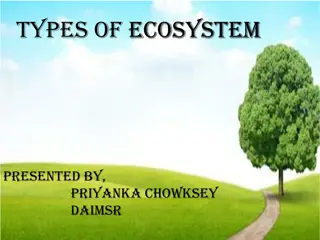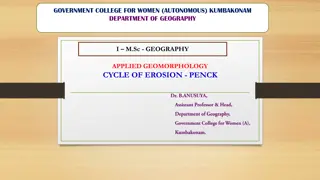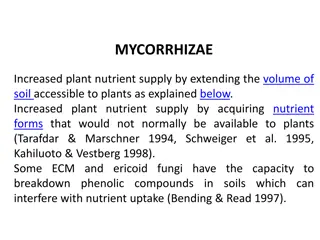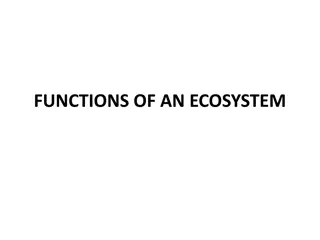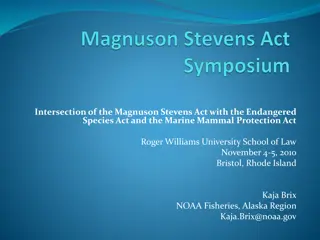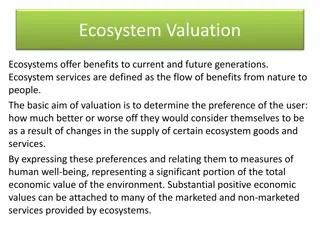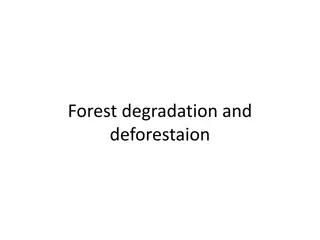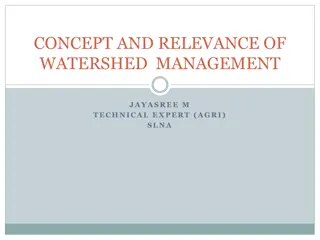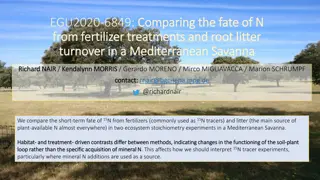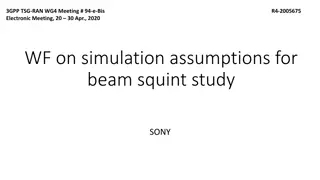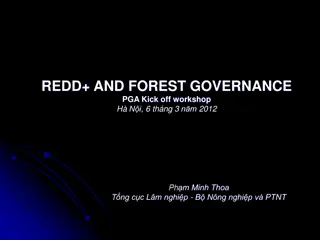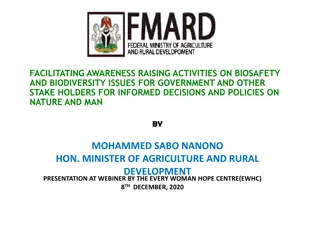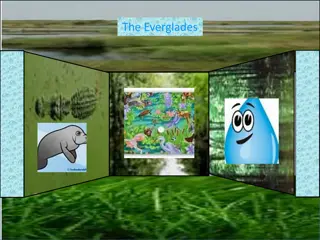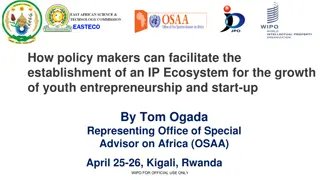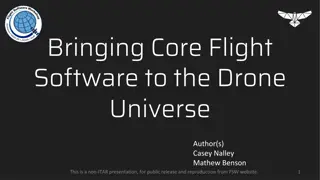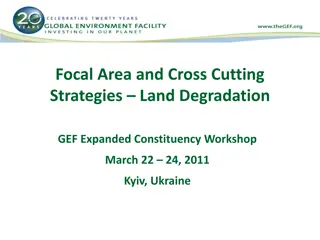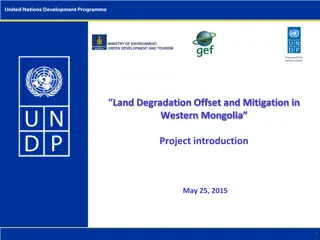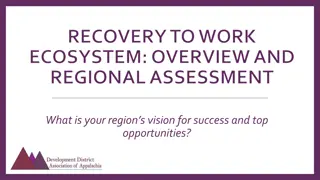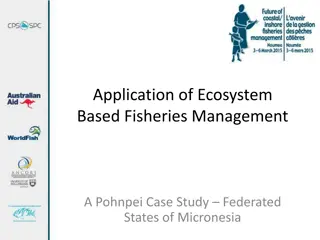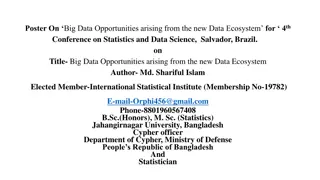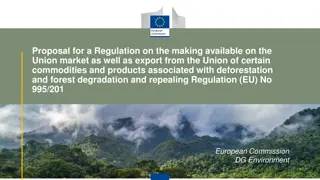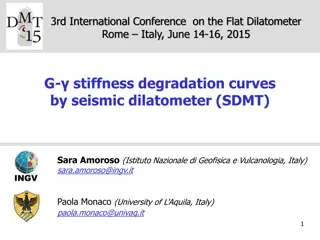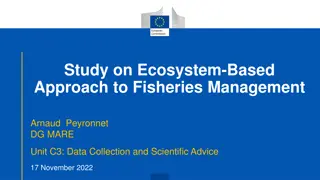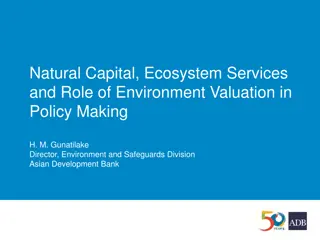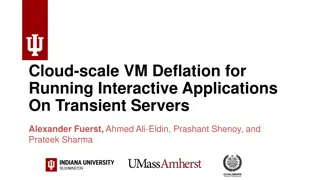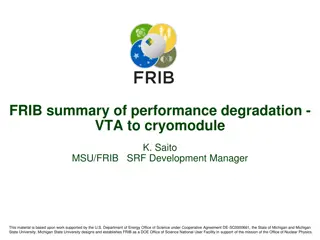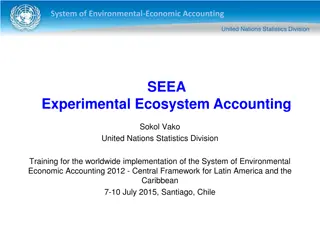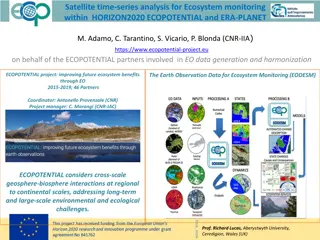Exploring Different Ecosystem Types and Functions
Learn about the major types of ecosystems such as Grassland, Aquatic, Forest, and Desert presented by Priyanka Chowksey of DAIMSR. Understand the components of an ecosystem, including biotic and abiotic factors, and the significance of different ecosystems like Forest Ecosystem and Desert Ecosystem.
4 views • 29 slides
Understanding Optical Fiber Signal Degradation in Communication Engineering
Technocrats Institute of Technology (Excellence) in Bhopal delves into the concepts of signal degradation in optical fiber communication, focusing on attenuation, distortion mechanisms, and measurement techniques. The institute emphasizes the importance of signal attenuation and its impact on inform
4 views • 56 slides
An Ecosystem Services Approach to Water Resources
Discover the world of ecosystem services through mapping and classifying services provided by different landscapes using Google Earth. Learn how to link Google Earth to photographs and investigate various features to understand the production of ecosystem services over time.
2 views • 15 slides
Understanding Pharmaceutical Degradation: Types and Factors
Pharmaceutical degradation refers to the process of a formulation in a specific container losing its chemical, microbiological, therapeutic, physical, and toxicological specifications. It can be categorized into physical, chemical, and microbiological degradation. Physical degradation alters the dru
1 views • 50 slides
Overview of O-RAN SC Bronze Release Objectives and Timelines
The content delves into the objectives of the OSC Bronze release focusing on end-to-end RAN communications and traffic steering use cases. It highlights the key elements of the Bronze release like health checks, RAN ecosystem connectivity, and timelines for bi-annual releases. Additionally, it discu
0 views • 18 slides
Solutions to Combat Land Degradation in the Sahel Region
Addressing land degradation in the Sahel through solutions like diguettes, managing grazing areas, and farmer education can help increase crop yields, prevent soil erosion, and promote sustainable land management. While these solutions have proven effective in various regions, challenges such as ini
1 views • 23 slides
Understanding Penck's Cycle of Erosion in Geomorphology
Walther Penck introduced an alternative model to Davisian cycle, emphasizing the interplay between upliftment and erosion rates in landscape formation. Penck's concept focuses on relative intensity of degradation processes, phase of upliftment, and rates of erosion, rejecting the idea of stages in l
2 views • 32 slides
Understanding Polymer Degradation Processes in Chemistry
Polymer degradation involves a reduction in molecular weight due to various factors like heating, mechanical stresses, radiation, oxygen, and moisture. Two main types of degradation include chain end degradation and random degradation, each affecting the polymer structure differently. Chain end degr
0 views • 12 slides
Benefits of Mycorrhizae in Plant Nutrition and Ecosystem Health
Mycorrhizae play a crucial role in enhancing plant nutrient uptake, protecting against pests, improving plant growth, and fostering ecosystem stability. These symbiotic relationships provide various benefits such as increased nutrient supply, protection from pathogens, enhancement of plant growth fo
0 views • 9 slides
Enhancing Land Degradation Neutrality Targets in Lebanon's National Action Programme
Integrating LDN targets into Lebanon's National Action Programme, led by Dr. Chadi Mohanna, aims to align the NAP with the UNCCD's 10-Year Strategy, set national targets for Land Degradation Neutrality, and implement measures to combat land degradation aggravated by climate change. The project focus
0 views • 23 slides
Understanding the Key Functions of an Ecosystem
Ecosystem functions are vital for the survival of various components within them, with energy flow, nutrient circulation, and biogeochemical cycles playing significant roles. Energy flow starts with solar radiation and sustains producers, consumers, and decomposers, highlighting the interconnectedne
0 views • 21 slides
Ecosystem Considerations in Fisheries Management Laws
Analysis of the intersection of the Magnuson Stevens Act, Endangered Species Act, and Marine Mammal Protection Act in addressing ecosystem considerations within fisheries management. Evaluation of current regulatory frameworks and the need for an ecosystem-based approach towards fisheries and apex p
0 views • 15 slides
Exploring Ecosystem Dynamics: Food Chains, Energy Pyramids, and Trophic Levels
An exploration of key concepts in ecosystem dynamics, including food chains, energy pyramids, secondary consumers, and trophic levels. Discover the interconnected relationships between organisms in an ecosystem and the vital role of key species. Dive into the differences between food chains and food
0 views • 16 slides
Understanding Ecosystem Valuation and Non-Market Techniques
Ecosystem valuation aims to assess user preferences for ecosystem goods and services, determining the economic value attached to nature's benefits. Ecosystems offer provisioning, regulating, cultural, and supporting services crucial for human well-being. Various non-market valuation techniques like
0 views • 5 slides
Understanding Deforestation and Forest Degradation: Causes and Impacts
Deforestation and forest degradation are significant environmental issues driven primarily by agriculture, logging, and population growth. Other causes include corruption, inequitable distribution of wealth and power, and urbanization. Globalization and historical exploitation also play a role. Deve
0 views • 53 slides
Urgency of Watershed Management for Sustainable Agriculture
Watershed management is crucial due to dwindling land availability, water scarcity projections, and the severe threat of soil erosion and land degradation. With vast regions affected by these issues, especially in rainfed areas, there is a pressing need to address resource degradation to ensure food
0 views • 50 slides
Understanding Nitrogen Dynamics in a Mediterranean Savanna Ecosystem
Investigating the fate of nitrogen from fertilizer treatments and root litter turnover in a Mediterranean Savanna ecosystem. The study compares the short-term fate of 15N tracers in ecosystem stoichiometry experiments, highlighting changes in soil-plant functioning. The research addresses N turnover
0 views • 10 slides
Simulation Assumptions and Performance Degradation Study on Beam Squint in 3GPP Meeting
Background on beam squint in conducted power of transmitted CCs causing radiative domain impairment and gain droop, with a problem statement on degradation of CC2 spherical coverage when CC1 and CC2 are separated by frequency. The study involves refined simulation assumptions to quantify radiative d
0 views • 7 slides
Understanding REDD+ and Forest Governance for Sustainable Resource Management
REDD+ stands for Reducing Emissions from Deforestation and forest Degradation, encompassing activities to enhance carbon stocks, conservation, and sustainable forest management. Forest governance plays a crucial role in reducing risks related to land use change, illegal logging, and forest degradati
0 views • 11 slides
Understanding Purine Degradation and Gout
Purine degradation pathway involves the breakdown of dietary nucleic acids, mainly from meat, into uric acid through specific enzymatic steps. Excessive uric acid production can lead to conditions like gout and hyperuricemia. Humans excrete uric acid in the urine as the final product, while other an
1 views • 12 slides
Addressing Land Degradation Challenges in Agriculture for Sustainable Development
World agriculture has evolved over the decades, facing challenges like environmental degradation and land misuse. Awareness-raising activities on biosafety and biodiversity are crucial for informed decision-making in agriculture. Nigeria, with its diverse ecological zones, must sustainably manage na
0 views • 13 slides
Discovering the Diverse Ecosystem of the Everglades
The Everglades ecosystem in southern Florida is unique, offering a mix of temperate and tropical zones that support a wide variety of flora and fauna. Home to endangered species like the Florida panther and American crocodile, the region's wet climate and sawgrass landscapes make it a crucial habita
0 views • 4 slides
Impact of Land Development on Stream Ecosystem Health in Mill Brook Preserve, NY, USA
The study focuses on the effects of land development on stream ecosystem health in the Mill Brook Preserve in New Paltz, NY. It discusses the degradation of water quality due to surrounding land development and the importance of macroinvertebrates as indicators of ecosystem health. The review of lit
0 views • 23 slides
Facilitating an Intellectual Property Ecosystem for Youth Entrepreneurship Growth
In order to facilitate the establishment of an intellectual property ecosystem for the growth of youth entrepreneurship and start-ups, policy makers can take various interventions including revisiting the IP ecosystem, the need for evidence-based decision making, development of startups policies and
0 views • 9 slides
Revolutionizing Drone Operations with Windhover Ecosystem
Windhover Ecosystem, developed through NASA SBIR Phase I and II, offers a robust and open-source software solution for drone operations. The ecosystem includes integrated flight and ground control software, providing scriptable flight control, rapid prototyping, and full autonomy capabilities. Lever
0 views • 23 slides
Achievements and Strategies in Land Degradation Management
The Global Environment Facility (GEF) has made significant investments in sustainable land management, particularly in drylands, to combat land degradation through projects in over 40 countries. The objectives include maintaining agro-ecosystem services, generating sustainable forest ecosystem servi
0 views • 10 slides
5 Steps Questionnaire on Mapping Land Degradation and Sustainable Land Management
Preparation for mapping land degradation and sustainable land management involves steps such as preparing the base map, identifying contributing specialists, assessing land use systems, understanding land degradation types, and providing expert recommendations. The process includes analyzing area tr
0 views • 32 slides
Land Degradation Offset and Mitigation in Western Mongolia Project Overview
This project in Western Mongolia aims to address land degradation issues caused by mining activities by implementing offsetting principles, supporting pasture restoration, and enhancing biodiversity conservation. With a total funding of 6,569,863$, the project targets to conserve ecosystem integrity
0 views • 19 slides
Regional Recovery to Work Ecosystem Assessment and Goals
In this assessment, the focus is on the vision for success and top opportunities within the Recovery to Work Ecosystem. Goals include organizing stakeholders, engaging and supporting businesses, and providing wrap-around support for jobseekers. The discussions cover collaborative efforts, strengths,
0 views • 8 slides
Ecosystem-Based Fisheries Management in Pohnpei: A Case Study
The application of ecosystem-based fisheries management in Pohnpei, Federated States of Micronesia, involves a top-down regulatory history followed by a bottom-up approach focusing on the establishment of marine protected areas. The characteristics of Pohnpei's coral reef fisheries show declines in
0 views • 18 slides
Big Data Opportunities in the New Data Ecosystem
A data ecosystem encompasses infrastructure, analytics, and data analysis, fostering partnerships and coordination to leverage the power of data. This ecosystem, driven by Big Data technologies and deep analytical talent, aims to address complex business challenges and drive innovation. The integrat
0 views • 5 slides
Regulation Proposal to Combat Deforestation and Forest Degradation in the European Union
The European Commission is proposing a regulation to prevent the entry and export of commodities linked to deforestation and forest degradation. This aligns with political commitments such as the European Green Deal and the Farm to Fork Strategy. Existing legislation like the FLEGT Regulation and th
0 views • 32 slides
Insights into Soil Stiffness Degradation Using Seismic Dilatometer Data
This content discusses the analysis of soil stiffness degradation curves using data collected from the Flat Dilatometer and Seismic Dilatometer tests. Researchers Sara Amoroso and Paola Monaco present methods for deriving in situ G- decay curves and evaluating shear strain data in various soil types
0 views • 18 slides
Understanding Biodiversity: Importance and Implications
Biodiversity encompasses the variety of plant and animal life on Earth, including genetic, species, and ecosystem diversity. It plays a crucial role in maintaining ecological balance and ecosystem processes. Traits and interactions among species influence ecosystem function, emphasizing the signific
0 views • 14 slides
Ecosystem-Based Approach to Fisheries Management Study Overview
The study focuses on assessing the current state of implementing Ecosystem-Based Approach to Fisheries Management (EAFM) within the EU, providing recommendations to address challenges and advance towards the objectives of the Common Fisheries Policy (CFP). It outlines a systematic evaluation of exis
0 views • 24 slides
Understanding Natural Capital and Ecosystem Services Valuation for Effective Policy Making
Natural capital and ecosystem services play a crucial role in shaping policies related to environmental conservation and resource management. Valuing ecosystem services helps assess human welfare impacts and address market failures in allocating resources. Issues such as land degradation and loss of
0 views • 24 slides
Cloud-Scale VM Deflation for Running Interactive Applications on Transient Servers
This research explores the concept of deflatable virtual machines to run interactive applications on transient cloud servers without facing unexpected preemption. By reclaiming resources from low-priority VMs and allowing forward progress with some performance degradation, the method aims to provide
0 views • 29 slides
Performance Degradation Summary for FRIB Cryomodule VT vs. Bunker
FRIB's performance degradation analysis focuses on validating the design of the cryomodule, with tests conducted under various operational conditions to assess parameters such as cryogenic losses, SRF subsystems performance, and cavity dynamics. The ReA6-1 cavity's performance, measured in terms of
0 views • 5 slides
System of Environmental-Economic Accounting and Experimental Ecosystem Accounting Overview
The System of Environmental-Economic Accounting (SEEA) and Experimental Ecosystem Accounting aim to integrate biophysical data, monitor ecosystem changes, and link them to economic activities. They provide a framework for accounting for ecosystem assets and services, playing a crucial role in the po
0 views • 34 slides
Satellite Time-Series Analysis for Ecosystem Monitoring in ECOPOTENTIAL Project
This project, part of HORIZON2020 and ERA-PLANET, focuses on satellite time-series analysis for ecosystem monitoring at regional to continental scales. It aims to improve ecosystem benefits through Earth Observation data, contributing to UN Sustainable Development Goal 15 by protecting, restoring, a
0 views • 19 slides
